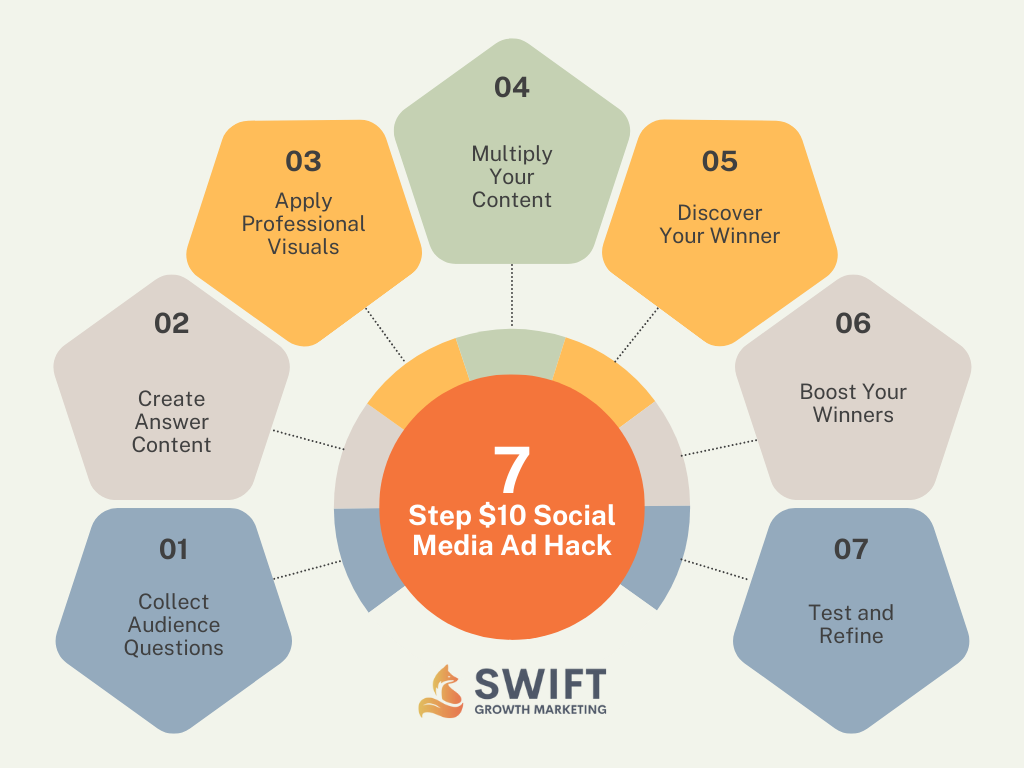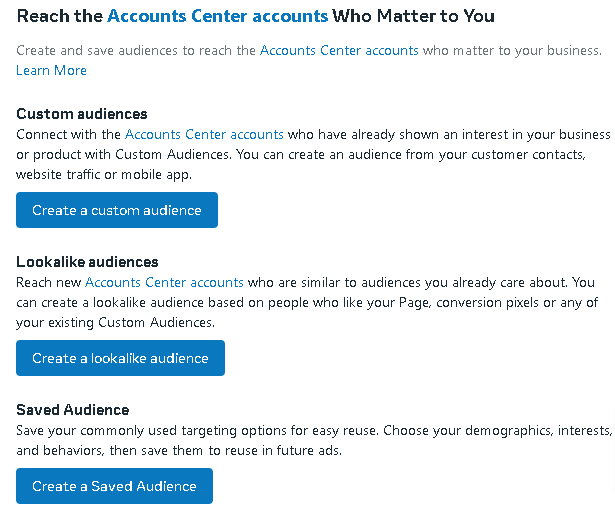
Imagine this: You’re a small business owner. You’ve poured your heart (and limited budget) into a social media ad campaign for your newest offerings. You’re excited, hoping for a rush of new customers. But…crickets. Sound familiar?
Many small businesses face this challenge. They invest in paid advertising, hoping to reach new customers, but often have little to show. The frustration is real, and the wasted budget hurts even more.
There’s a more innovative way: a $10 hack that lets you test your content before you boost it, potentially saving you thousands of dollars in wasted ad spending.
This article reveals a step-by-step process to validate your content ideas organically, ensuring your paid ads hit the mark when you’re ready to scale.
The Problem: Why Traditional Ad Strategies Fail Small Businesses
Limited budgets define the reality of small business operations. Every dollar matters, and there’s no room for expensive marketing experiments. When a business operates on tight margins, wasting money on ineffective ads isn’t just disappointing—it potentially devastates growth.
Untargeted Approach
Most small businesses fall into the trap of using broad, unfocused ad campaigns. It’s like casting a wide net in the ocean when you’re only looking for one type of fish. While this approach occasionally catches something valuable, it typically results in wasted effort and resources.
Lack of Data-Driven Decisions
Success in advertising relies on data, not hunches. Without proper testing, businesses make decisions based on assumptions rather than actual audience behavior. This leads to promoting content that might look good internally but fails to resonate with potential customers.
The Guessing Game
Traditional advertising often involves expensive trial and error. Business owners guess what content will work, invest heavily in promoting it, and then hope for the best. This approach turns marketing into a high-stakes gamble rather than a strategic investment.
The Solution: Content Testing – A Low-Cost Way to Win
Content testing is your marketing dress rehearsal before the big show. It is a low-risk way to validate your ideas with a small audience before investing significant resources into promotion.
What is Content Testing?
Content testing means sharing your social media content organically first, then using minimal ad spend to gauge its potential with your target audience. This process reveals which posts, images, or videos naturally resonate with your market before you commit to a more considerable advertising investment.
Why Organic Testing?
Organic testing provides real-world feedback without the pressure of paid promotion. Your audience’s natural reaction to your content offers invaluable insights into what they truly value, not just what they click on when it’s promoted. This authentic engagement becomes your roadmap for future ad spend.
The $10 Advantage
With just $10, you can gather valuable data that might save you thousands in misplaced ad spend. This micro-investment approach allows you to:
- Test multiple content pieces affordably
- Gather real engagement metrics
- Identify your most promising content
- Make data-driven decisions about more significant ad investments
Benefits Recap
This approach helps you avoid costly mistakes, maximize your ad spend, and make informed decisions based on user behavior rather than assumptions. Most importantly, it turns your marketing from a guessing game into a strategic process.
The $10 Hack: A Step-by-Step Guide

Step 1: Collect Target Audience Questions
Understanding your audience’s needs starts with thorough research into their questions and concerns. Begin by exploring platforms where your target customers actively seek information. Tools like AnswerThePublic reveal common search queries related to your industry, while AlsoAsked shows you the follow-up questions people typically ask (more topic research tools).
Dive into Quora discussions within your niche. Pay special attention to recurring themes and pain points in the questions. Don’t just look at the questions—study the following comments and discussions. These often reveal additional concerns your content should address.
Your existing content also holds valuable insights. Review comments on your social media posts, blog articles, and customer service interactions. What patterns emerge? Which topics generate the most engagement? This firsthand data from your audience is pure gold for content creation.
Step 2: Create Answer Content
With your audience research in hand, it’s time to create content that directly addresses their needs. The key is to develop comprehensive answers that work across multiple formats. Start with a thorough written piece that covers all aspects of the question. Think of this as your content foundation.
When crafting your content, focus on clarity and actionable insights. If your audience asks about reducing business costs, don’t just list generic tips—provide specific, implementable steps backed by actual examples. Your content should equip readers to take action immediately after reading it.
Consider different learning styles and consumption preferences. Some people prefer step-by-step guides, while others respond better to story-based explanations. Create content that accommodates these different preferences while maintaining your core message.
Step 3: Apply Professional Visuals
Visual appeal matters, but it doesn’t require a massive budget. Start with free stock photo sites like Unsplash and Pexels, but be strategic in your selections. Look for images that align with your brand aesthetic and message—avoid generic, overused business photos.
Canva offers professionally designed templates you can customize for your brand. To create a consistent visual style guide, select two to three main colors, stick to a specific font family, and maintain consistent spacing and layout patterns. This consistency helps build brand recognition even with free tools.
Adobe Express takes your visuals further with advanced features for creating professional-looking graphics. Use it to design custom headers, social media cards, and infographics that break down complex information into digestible visual formats.
Step 4: Multiply Your Content
Don’t let perfectionism paralyze you. While quality matters, done is better than perfect when testing content. Your competitors are learning and improving while you’re stuck in endless revisions.
Start With What You Have
Turn one solid blog post into multiple pieces of content. Your first attempts won’t be perfect—and that’s okay. Testing helps you improve based on actual audience feedback, not assumptions.
Tips for Each Platform
Create four variations for each platform. This way, you have a post per week. Link to the blog post each time.
For LinkedIn:
- Share your key business insight
- Add relevant industry context
- Ask for professional opinions
For Facebook:
- Keep it conversational
- Include a personal angle
- Encourage discussion
For Instagram:
- Create simple visual quotes
- Break concepts into carousel slides
- Share quick-tip graphics
Monthly Expansion
- Bundle top insights into a newsletter
- Write a LinkedIn article
- Adapt your best content into new formats
Remember: Speed of implementation often beats perfection. Get your content out there, test it, and improve based on real engagement. Your audience would rather see consistent, helpful content than wait months for that “perfect” post that might never come.
Step 5: Discover Your Winner
Here’s where your $10 investment comes into play. But first, let’s clear up a common misconception: success isn’t just about likes and reactions. Here’s what matters:
Track These Metrics First:
- Shares: People sharing your content is the strongest signal of value
- Meaningful comments: Look for actual conversations, not just emojis
- Click-throughs: Are people interested enough to learn more?
- Save/bookmark rates: Shows people find your content worth keeping
The $10 Test Process:
- Pick your top 2-3 organically performing posts
- Set up a small test campaign for each:
- $10 budget
- 24-hour runtime
- Target your core audience
- Start with the engagement objective
What Good Performance Looks Like:
Don’t expect viral numbers. Look for:
- Early engagement (first 2-4 hours)
- Quality over quantity in responses
- People tagging others naturally
- Questions and genuine interest in comments
Pro Tip: A post with 10 thoughtful comments and 5 shares might be more valuable than one with 100 likes but no meaningful engagement.
Step 6: Target and Boost Your Winners
Start Small, Think Big
Begin with a modest $25-50 budget spread across 3-5 days. This gives your content enough runway to prove itself while keeping risk low. Monitor daily, but resist making changes in the first 24 hours – the platform needs time to optimize delivery.
Build a Strategic Audience
Your warmest audience should see your content first. These are your existing followers and website visitors who already know your brand. Once you see strong engagement, expand to lookalike audiences that mirror your best customers’ characteristics. This targeted approach beats broad reach every time.
Watch These Key Indicators
- Engagement rates holding steady or improving
- Cost per engagement staying consistent
- Positive comments and genuine interactions
- Share rates maintaining momentum
- Click-through rates for any included links
When to Hit Pause
If you notice engagement dropping suddenly or costs spiking, don’t panic. Pause the campaign and review your targeting. Sometimes, a slight adjustment to your audience parameters or a refresh of the creative can get things back on track.
Scaling Successfully
Have you found a winner? Scale gradually with 20% budget increases rather than dramatic jumps. This measured approach helps maintain performance while expanding reach. As you grow, keep monitoring those key indicators.
Step 7: Keep Testing and Refining
Build Your Testing Routine
Success in social media requires consistent testing and refinement. Set aside time each month to test new content ideas. Maybe it’s every first and third Monday. The key is to make testing a regular habit, not a one-time experiment.
Document Everything
Keep a simple testing log capturing:
- Content type and format
- Target audience details
- Initial $10 test results
- Scaled campaign performance
- Key audience reactions
- Cost per desired outcome
Learn From Data, Not Assumptions
Each test, whether successful or not, provides valuable insights. Did your how-to video outperform your industry news update? Did morning posts generate better engagement than afternoon content? Use what you have learned to shape your next test.
Evolve With Your Audience
Your audience’s preferences will change over time. What worked last quarter might not resonate today. Stay nimble and ready to adapt your content strategy based on test results rather than sticking to a rigid formula.
Buffer’s Study: The Power of Even Just $5
Remember how we’ve been talking about starting with $10 tests? Here’s something that might surprise you – Buffer discovered you can achieve meaningful results with even less. Their experiment with just $5 daily on Facebook ads revealed fascinating insights about micro-budget advertising.
What Buffer Discovered
When Buffer tested minimal ad spends, it found that even $5 could generate significant engagement, including meaningful page likes and substantial click-throughs to its website. Its boosted posts showed impressive reach increases without breaking the bank.
This aligns perfectly with Gary Vaynerchuk’s observation that Facebook advertising is underpriced. During his keynote at AdExchanger’s Industry Preview, he emphasized that Facebook advertising presents a unique opportunity for businesses willing to test and learn, even with minimal budgets.
The Key Takeaway
If Buffer could achieve meaningful results with $5, imagine what you could learn from our recommended $10 test. The point isn’t the exact dollar amount – it’s about starting small, testing smart, and scaling what works. Whether you begin with $5 or $10, the principle remains the same: validate before you invest heavily.
Conclusion
The path to successful social media advertising doesn’t require a massive budget or a marketing degree. It starts with a simple $10 test – or even $5 if you’re beginning. The key is shifting your mindset from “spend big and hope” to “test small and know.”
Every major brand today started somewhere. They didn’t achieve success by mindlessly throwing money at ads – they got there through careful testing and learning from their audience. You now have the same testing tools, which are more accessible than ever.
Ready to stop wasting your ad budget and start seeing actual results? Begin with one piece of content this week. Test it with $10, analyze the results, and scale what works. Your future campaigns (and your marketing budget) will thank you. If you could use some help, get in touch with us.


